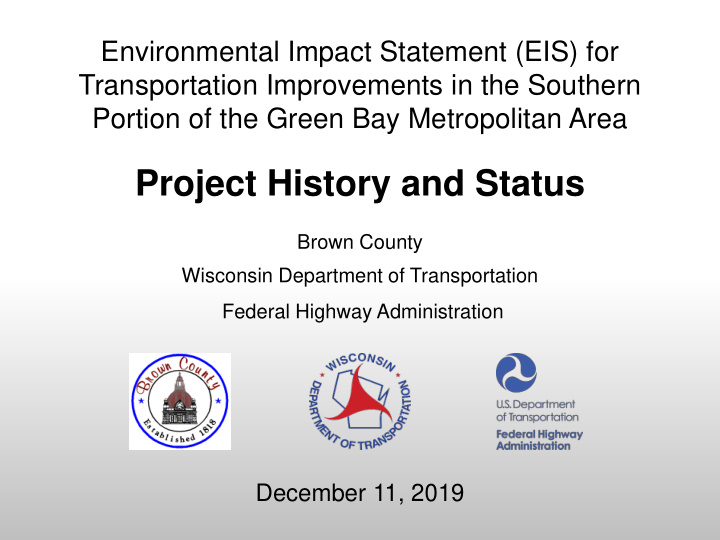



Environmental Impact Statement (EIS) for Transportation Improvements in the Southern Portion of the Green Bay Metropolitan Area Project History and Status Brown County Wisconsin Department of Transportation Federal Highway Administration December 11, 2019
Southern Bridge Corridor Project History • Southern Bridge concept included in 1968 Brown County Plan. • 1996 Brown County Plan recommended a general Southern Bridge corridor location. • Planning work continued from 1996 to 2006. • EIS development process began in 2006. • EIS process needed to include development of an Interstate Access Justification Report (IAJR) for US 41 because it was planned to become an Interstate Highway.
Original EIS Study Area Brown County began working with the Wisconsin Department of Transportation (WisDOT) and Federal Highway Administration (FHWA) in 2006. EIS study area originally included portions of: City of De Pere Village of Hobart Village of Allouez Town of Glenmore Village of Ashwaubenon Town of Lawrence Village of Bellevue Town of Ledgeview Village of Wrightstown* Town of Rockland *The State Highway 96 bridge in Wrightstown was included as a secondary study area.
Original EIS Purpose • Identify the most appropriate improvements for addressing existing and projected travel demand in the southern portion of the Green Bay Metropolitan Area. Original EIS “Need” • Improve traffic capacity in the area (reduce congestion on/near Downtown De Pere Bridge, etc.). • Improve transportation linkages in the area (provide more east-west routes for all transportation modes). • Accommodate future travel demand generated by development identified in local/county/regional land use plans. • Improve transportation safety in the area. *Received Purpose & Need Concurrence in 2008*
Original Range of Alternatives Four options were considered for addressing the EIS Purpose and Need: • Build Nothing (No-Build Alternative) . • Transportation Demand Management (TDM) Strategies . o Diverting people to other transportation modes (e.g. public transit). o Providing alternatives to making certain trips (e.g. telecommuting for work trips). • Transportation System Management (TSM) Strategies . o Improving the efficiency of existing streets/highways to avoid having to expand them or build new ones (e.g. removing parking, restriping streets to add left turn lanes). • New Construction .
Original Range of Alternatives The No-Build, TDM, and TSM options would not adequately address the EIS Purpose and Need. At the time, new construction was believed to be the only way to adequately address the Purpose and Need. Construction alternatives were identified by: • EIS Lead and Cooperating Agencies. • Stakeholder Committee (Communities, School Districts, etc.). • The Public (April 2009 Public Information Meeting). • Community Comprehensive Plans. • Community and Regional Transportation Plans/Studies.
22 Build Alternatives
Original Range of Alternatives Screened all construction options based on EIS Purpose & Need as well as nine project objectives identified at the beginning of the EIS process. Presented the results to the public at a Public Information Meeting (PIM) in May of 2010, incorporated public comments into screening process. Recommended eliminating many alternatives from further study based on results of screening process. *Received Alternatives Retained for Detailed Study Concurrence in 2011*
Draft EIS Document Development Conducted detailed study of the remaining alternatives. 20+ environmental impacts were studied in detail. Examples: - Economic (business retention and attraction) - Social (neighborhoods, schools, etc.) - Air and water quality - Archaeological and historical resources - Threatened/endangered species Presented findings to EIS Stakeholder Committee and Cooperating Agencies. *Completed Original Draft EIS in 2012*
Post-2012 Activities • EIS process suspended to conduct an operations and engineering analysis to screen remaining corridor alternatives. • Brown County worked with a consulting firm on this analysis between 2012 and 2019. • During this time, sections of corridor alternatives were eliminated. o County Highway GV because it needed to be reconstructed before EIS would be finished (a separate environmental document was prepared for GV). o County Highways G and MM because these were not expected to be expanded and would no longer be connected to EIS corridors after GV was eliminated. • Also, EIS would now be prepared as a Tier I document because there was no reasonable expectation money would be available for the project when EIS is finished (federal fiscal constraint requirement).
Next Steps • Validate pre-2012 findings (e.g. Purpose & Need, Alternatives). • Update information collected before operations/engineering analysis began in 2012. • Add information to Tier I EIS in response to new state/federal requirements. • Identify general location of Southern Bridge Corridor. • Complete Tier I EIS and obtain signed Record of Decision (ROD).
Next Steps **State has offered to design & build a new interchange for Southern Bridge Corridor as part of I-41 Expansion Project if ROD signed by October of 2020.** Brown County and communities directly impacted by corridors (Lawrence, De Pere, Ledgeview) jointly funding consulting team to help meet this deadline.
From WisDOT Secretary-Designee Craig Thompson to Brown County Executive Troy Streckenbach:
The Southern Bridge Project is Now: https://www.browncountywi.gov/departments/planning- and-land-services/planning/south-bridge-connector/
Questions or Comments?
Recommend
More recommend